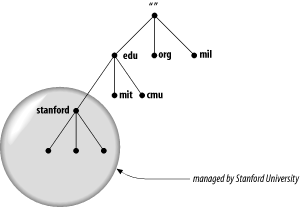2.3 Delegation
| Remember that one of the main goals of the design of the Domain Name System was to decentralize administration? This is achieved through delegation. Delegating domains works a lot like delegating tasks at work. A manager may break up a large project into smaller tasks and delegate responsibility for each of these tasks to different employees. Likewise, an organization administering a domain can divide it into subdomains. Each of those subdomains can be delegated to other organizations. This means that an organization becomes responsible for maintaining all the data in that subdomain. It can freely change the data and even divide its subdomain into more subdomains and delegate those. The parent domain retains only pointers to sources of the subdomain's data, so that it can refer queriers there. The domain stanford.edu, for example, is delegated to the folks at Stanford who run the university's networks (see Figure 2-7). Figure 2-7. stanford.edu is delegated to Stanford University Not all organizations delegate away their whole domain, just as not all managers delegate all their work. A domain may have several delegated subdomains and also contain hosts that don't belong in the subdomains. For example, the Acme Corporation (it supplies a certain coyote with most of his gadgets), which has a division in Rockaway and its headquarters in Kalamazoo, might have a rockaway.acme.com subdomain and a kalamazoo.acme.com subdomain. However, the few hosts in the Acme sales offices scattered throughout the U.S. would fit better under acme.com than under either subdomain. We'll explain how to create and delegate subdomains later. For now, it's important only that you understand that the term delegation refers to assigning responsibility for a subdomain to another organization. |
EAN: 2147483647
Pages: 163